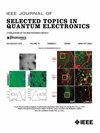Comprehensive Optimization of Interferometric Diffusing Wave Spectroscopy (iDWS)
IF 5.1
2区 工程技术
Q1 ENGINEERING, ELECTRICAL & ELECTRONIC
IEEE Journal of Selected Topics in Quantum Electronics
Pub Date : 2025-02-13
DOI:10.1109/JSTQE.2025.3537642
引用次数: 0
Abstract
Light speckle fluctuations provide a means for noninvasive measurements of cerebral blood flow index (CBFi). While conventional Diffuse Correlation Spectroscopy (DCS) quantifies these fluctuations to provide marginal brain sensitivity for CBFi in adult humans, new techniques have emerged to improve diffuse light throughput and brain sensitivity. Here we further optimize one such approach, interferometric diffusing wave spectroscopy (iDWS), with respect to the number of independent channels, camera duty cycle and full well capacity, incident laser power, noise and artifact mitigation, and data processing. We build the system on a cart and define conditions for stable operation. We show pulsatile CBFi monitoring at 4–4.5 cm source-collector separation in adults with moderate pigmentation (Fitzpatrick 4). We also report preliminary clinical measurements of patient CBFi in the Neuro Intensive Care Unit (Neuro ICU). These results push the boundaries of iDWS CBFi monitoring performance beyond previous reports.干涉散射波光谱(iDWS)的综合优化
光斑波动提供了一种无创测量脑血流指数(CBFi)的方法。虽然传统的漫射相关光谱(DCS)量化这些波动,以提供成年人CBFi的边际脑灵敏度,但新技术已经出现,可以提高漫射光吞吐量和脑灵敏度。在这里,我们进一步优化了一种这样的方法,干涉漫射波光谱(iDWS),涉及独立通道的数量、相机占空比和全井容量、入射激光功率、噪声和人为干扰缓解以及数据处理。我们将系统建立在手推车上,并定义了稳定运行的条件。我们展示了中度色素沉着的成人在4 - 4.5 cm源收集器分离处脉搏性CBFi监测(Fitzpatrick 4)。我们还报告了神经重症监护病房(Neuro ICU)患者CBFi的初步临床测量。这些结果突破了iDWS CBFi监测性能的界限,超越了以前的报告。
本文章由计算机程序翻译,如有差异,请以英文原文为准。
求助全文
约1分钟内获得全文
求助全文
来源期刊

IEEE Journal of Selected Topics in Quantum Electronics
工程技术-工程:电子与电气
CiteScore
10.60
自引率
2.00%
发文量
212
审稿时长
3 months
期刊介绍:
Papers published in the IEEE Journal of Selected Topics in Quantum Electronics fall within the broad field of science and technology of quantum electronics of a device, subsystem, or system-oriented nature. Each issue is devoted to a specific topic within this broad spectrum. Announcements of the topical areas planned for future issues, along with deadlines for receipt of manuscripts, are published in this Journal and in the IEEE Journal of Quantum Electronics. Generally, the scope of manuscripts appropriate to this Journal is the same as that for the IEEE Journal of Quantum Electronics. Manuscripts are published that report original theoretical and/or experimental research results that advance the scientific and technological base of quantum electronics devices, systems, or applications. The Journal is dedicated toward publishing research results that advance the state of the art or add to the understanding of the generation, amplification, modulation, detection, waveguiding, or propagation characteristics of coherent electromagnetic radiation having sub-millimeter and shorter wavelengths. In order to be suitable for publication in this Journal, the content of manuscripts concerned with subject-related research must have a potential impact on advancing the technological base of quantum electronic devices, systems, and/or applications. Potential authors of subject-related research have the responsibility of pointing out this potential impact. System-oriented manuscripts must be concerned with systems that perform a function previously unavailable or that outperform previously established systems that did not use quantum electronic components or concepts. Tutorial and review papers are by invitation only.
 求助内容:
求助内容: 应助结果提醒方式:
应助结果提醒方式:


